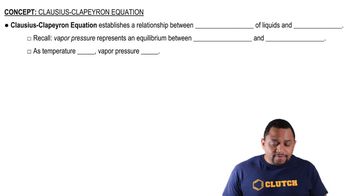Here are the essential concepts you must grasp in order to answer the question correctly.
Gibbs Free Energy (∆G)
Gibbs Free Energy (∆G) is a thermodynamic potential that measures the maximum reversible work obtainable from a thermodynamic system at constant temperature and pressure. It is crucial for predicting the spontaneity of a process; a negative ∆G indicates a spontaneous reaction, while a positive ∆G suggests non-spontaneity. In the context of vaporization, calculating ∆G helps determine whether the phase change from liquid to gas is favorable under given conditions.
Recommended video:
Gibbs Free Energy of Reactions
Vaporization and Boiling Point
Vaporization is the process by which a liquid turns into vapor, and the boiling point is the temperature at which this occurs at a specific pressure. For a substance to boil, its vapor pressure must equal the external pressure. Understanding the relationship between temperature, pressure, and vapor pressure is essential for predicting whether a liquid will boil at a given temperature and pressure, such as 1 atm.
Recommended video:
Clausius-Clapeyron Equation
The Clausius-Clapeyron equation describes the relationship between the vapor pressure of a substance and its temperature, providing a way to calculate changes in vapor pressure with temperature. This equation is particularly useful for determining the boiling point of a liquid at different pressures and for calculating ∆G for phase transitions. It highlights how temperature influences the equilibrium between phases, which is critical for understanding the boiling behavior of substances like benzene.
Recommended video:
Clausius-Clapeyron Equation
 McMurry 8th Edition
McMurry 8th Edition Ch.18 - Thermodynamics: Entropy, Free Energy & Equilibrium
Ch.18 - Thermodynamics: Entropy, Free Energy & Equilibrium Problem 86
Problem 86 Verified step by step guidance
Verified step by step guidance


